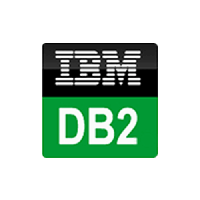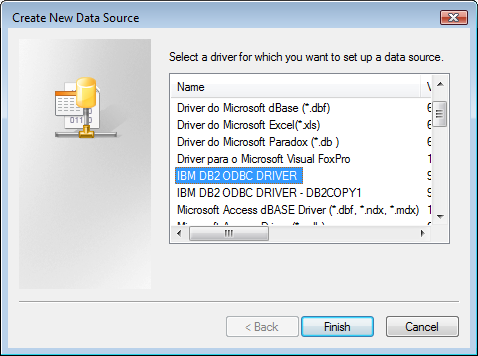I am new to working with IBM as/400 database. I heard of DB2.NET Data Provider that helps connect to this database, but not sure where to begin. Where do I fing this DLL and how to install this Pr. JDBC drivers for DB2 are not provided with Spectrum. However there are 3rd party drivers available for this environment, which are not supported by us. Db2 Warehouse In the web console for Db2 Warehouse, click Connect Connection Information and select the driver for your operating system. Db2 on Cloud and Db2 Warehouse on Cloud In the Db2 on Cloud and Db2 Warehouse on Cloud web console, click the gear icon next to your user name, and select Connection info. Select your operating system to.
[ Bottom of Page | Previous Page | Next Page | Contents | Index ]

Configuring the IBM DB2 JDBC Driver
IBM DB2 requires a type 2 Java Database Connectivity driver (JDBC driver) as the database client. The JDBC driver is used to connect a Java-based application to an IBM DB2 database that is running on either the same machine or a remote machine. In a clustered deployment of Tivoli Identity Manager, the JDBC driver enables all the Tivoli Identity Manager servers to communicate with the data source and share information. For more information, refer to IBM DB2 documentation.

- The JDBC driver that IBM DB2 product installs is called the IBM DB2 runtime client.
- To ensure that database connections are correctly released on Intel platforms, use TCP sockets. Do not use named pipes as the connection method on the IBM DB2 client. The named pipes method has a limit of the number of connections that cause Tivoli Identity Manager database errors.
Assuming that IBM DB2 is not installed on the target computer, you must install and configure the JDBC driver and required fix pack on the following targets. For more information, refer to the IBM Tivoli Identity Manager Release Notes.
- The computer that has the Network Deployment Manager
- Each cluster member on which you expect to install Tivoli Identity Manager Server
- On the computer that has a single-server installation, where IBM DB2 is remote.
On each target, do the following:
- Install and configure the JDBC driver and the required fix pack. Notes:
- AIX only: If the JDBC driver is on AIX, ensure that you also set the environment variable EXTSHM to ON.
Before starting the WebSphere Application Server on AIX, enter the following in a client session:
- You can add export EXTSHM=ON to the IBM DB2 profile. When the profile is sourced, the environment variable will be set.
- AIX only: If the JDBC driver is on AIX, ensure that you also set the environment variable EXTSHM to ON.
- Ensure that you have sourced the IBM DB2 profile with a valid db2InstanceHome directory. The default is:
- AIX, Linux, and HP-UX: /home/db2inst1
- Solaris: /export/home/db2inst1
To source the profile, enter the following command in an IBM DB2 command window:
The IBM DB2 profile must be sourced every time the WebSphere Application Server starts. Include this command in your .profile file to ensure this occurs.To verify that you successfully sourced the IBM DB2 profile, enter the following:
The resulting display is similar to the following:
- Catalog the database by taking the following steps:
- Open an IBM DB2 command window.
Enter su - <db2InstanceName> where <db2InstanceName> is the IBM DB2 instance owner such as db2inst1.
- In the command window on the client, execute this command on one line:
where:
- node db2node_hostname
- A local alias for the node to be cataloged. It is the host name of the computer on which the database resides. This user-defined value represents the internal IBM DB2 node name. The value of db2node_hostname cannot exceed eight characters in length.
- remote db2server_hostname
- Host name of the node on which IBM DB2 resides. The host name is the name of the node that is known to the TCP/IP network. For example, the name is db2server2host.
- server service-name|portnumber
- Specifies the service name or the port number of the server database manager instance. The default value of the IBM DB2 port number is 50000. Locate the current port number in the /etc/services file on the computer on which the IBM DB2 server resides. The port number on the client and the server must match. If a port number is specified, no service name needs to be specified in the local TCP/IP services file.
- Enter the following command to catalog the database:
- Open an IBM DB2 command window.
- To test that cataloging was successful, enter the following:
[ Top of Page | Previous Page | Next Page | Contents | Index ]

Summary: in this tutorial, you will learn how to interact with Db2 database servers using the SQL Developer tool.
Db2 Database Driver Download Free Photography Photos
SQL Developer is a free Database IDE that allows you to interact with databases using a graphical user interface instead of command-line tools like Db2 command line or Db2 command line plus. In the past, SQL Developer solely supported Oracle Database. However, by using third party plugins, you can use SQL developer to work with other database systems such as MySQL, SQL Server, or IBM Db2.
Driver Download
Download SQL Developer
Click the following link to download the SQL Developer program.

Note that you need to create an Oracle account in case you don’t have one before you can download it.
Download Plugin
Click the following link to download the JDBC Db2 driver version:
Connect to Db2 Using SQL Developer
Launch SQL Developer and follow these steps:
Step 1. Choose Tools > Preferences… menu item:
Step 2
Search for JDBC, you will find the Third Party JDBC Drivers under Database. Click the Add Entry… button
Step 3
Browse to the location that you store the JDBC driver file, in this case, it is db2jcc.jar under d:software directory. Click the Select button to choose the JDBC driver file and click the OK button to accept the JDBC driver.
Step 4
Click the New button to create a connection to the Db2 database server.

Step 6
Choose the database connection and click the OK button
Step 7
- Click the DB2 tab
- Provide the connection details including connection name, user, password, hostname port, and the database (Books) that you want to connect.
- Click the Test button to test the connection. If you see the status: success, it shows that the connection is fine.
- Click the Save button to save the connection and then click the Connect button to connect to the Books database on the local DB2 database server.
Step 8
You will see the following query editor.
Enter the following command and click the Run button, you will get the output:
In this tutorial, you have learned how to use the SQL Developer to interact with a database on the Db2 database server.